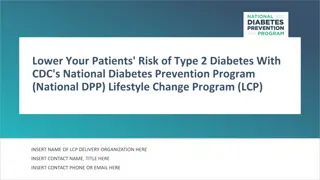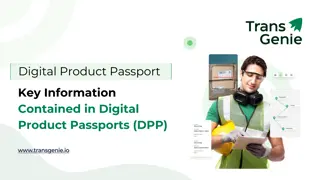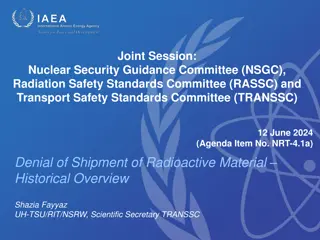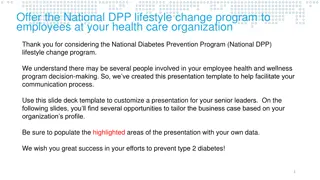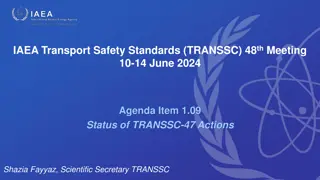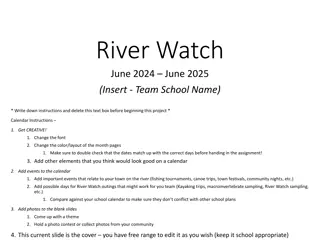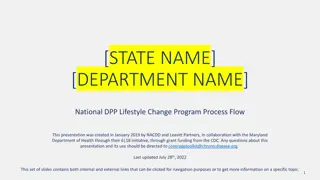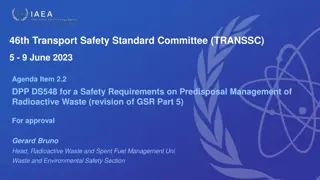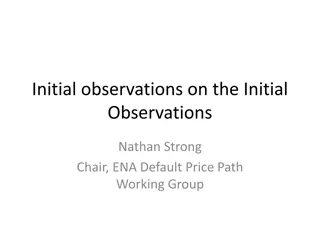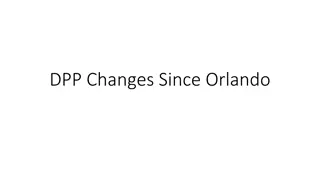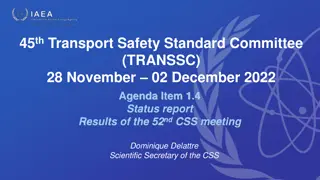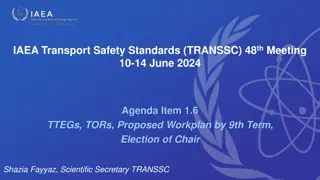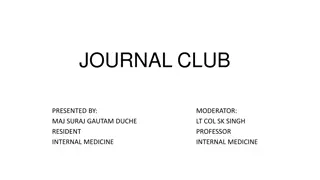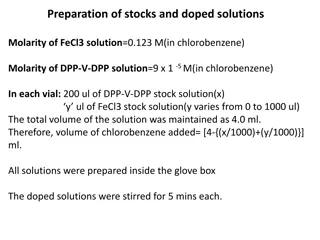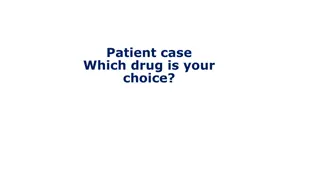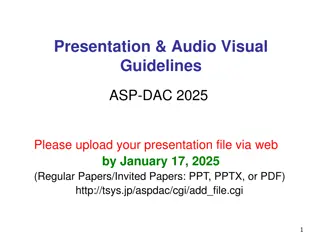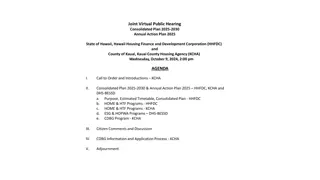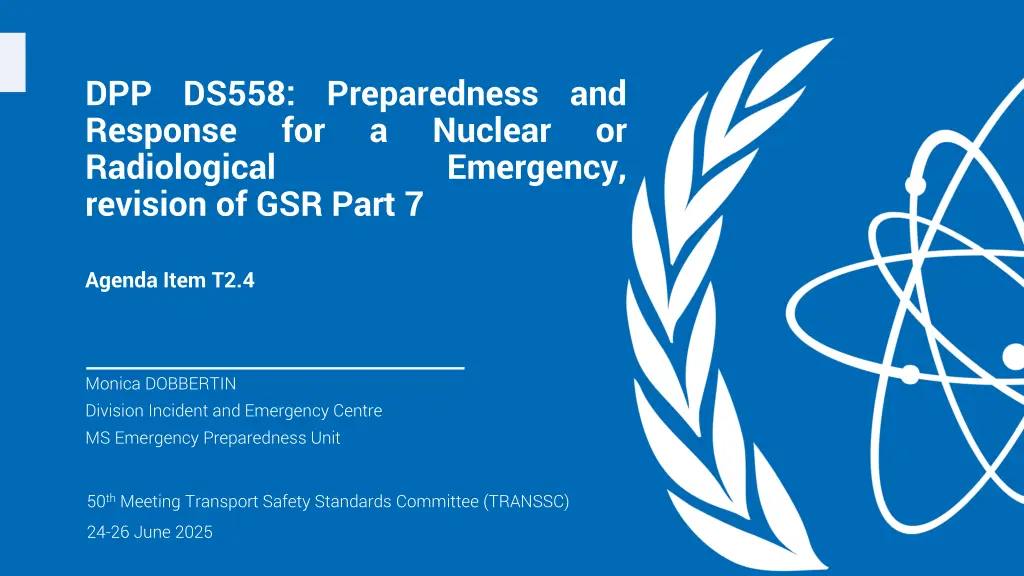
Radiological Revision of GSR Part 7: Preparedness for Nuclear Emergencies Agenda Item T2.4
Explore the revision process of Safety Standard GSR Part 7 focusing on preparedness and response for nuclear emergencies, integrating feedback from disruptive situations like the Covid-19 pandemic. Learn about the objectives, scope modifications, and key considerations for updated requirements in nuclear safety standards.
Download Presentation

Please find below an Image/Link to download the presentation.
The content on the website is provided AS IS for your information and personal use only. It may not be sold, licensed, or shared on other websites without obtaining consent from the author. If you encounter any issues during the download, it is possible that the publisher has removed the file from their server.
You are allowed to download the files provided on this website for personal or commercial use, subject to the condition that they are used lawfully. All files are the property of their respective owners.
The content on the website is provided AS IS for your information and personal use only. It may not be sold, licensed, or shared on other websites without obtaining consent from the author.
E N D
Presentation Transcript
DPP Response Radiological revision of GSR Part 7 DS558: Preparedness a Nuclear and or for Emergency, Agenda Item T2.4 Monica DOBBERTIN Division Incident and Emergency Centre MS Emergency Preparedness Unit 50thMeeting Transport Safety Standards Committee (TRANSSC) 24-26 June 2025
Background (1/2) The Safety Standard that is being revised: GSR Part 7: Preparedness and Response for a Nuclear or Radiological Emergency (2015) The current revision was initiated to: integrate feedback and lessons learned from disruptive situations that might affect the safety of facilities and activities (e.g., the Covid-19 pandemic) cover and reflects the nuclear and radiation safety developments and updates (e.g., new or innovative nuclear technologies), and integrate the latest developments in the system of radiation protection To be revised with due consideration of 57th meeting (session 4) of the Commission on Safety Standards held in May 2025
Background (2/2) Risks related to the production of the safety standard: new technologies to be addressed; better understanding is needed on their impact on the hazard assessment developments in the system of radiation protection to be captured in agreement with how these are reflected in the IAEA safety standards; publication may be delayed at some moment in time, to consider harmonization with Safety Fundamentals and/or GSR Part 3 when these would be revised as well to integrate latest developments availability of human resource involved in its revision, to ensure continuity in draft development
Objective and Scope DS558 will supersede GSR Part 7 GSR Part 7 (Rev. 1) Objective and Scope modified in line with GSR Part 7, with focus on updating of existing requirements to integrate comments from SSC All facilities and activities are included, as defined in the IAEA safety standards Outcome: revised set of consolidated requirements for an adequate level of preparedness and response for a nuclear or radiological emergency, irrespective of its cause
Objective Initial DPP Feb 2025 The objective of the proposed publication is to revise the existing, and establish new, EPR requirements for the protection of workers, emergency workers and helpers, the public, and the environment in the event of a nuclear or radiological emergency, regardless of the triggering event. After revision, based on comments SSC The present publication establishes the requirements for an adequate level of preparedness and response for a nuclear or radiological emergency. The application of these requirements is also intended to mitigate the consequences of a nuclear or radiological emergency if such an emergency arises despite all efforts made to prevent it. The objective of the proposed publication is to revise the existing, and establish new, EPR requirements for the protection of workers, emergency workers and helpers, the public, and the environment in the event of a nuclear or radiological emergency, regardless of the triggering event. The fulfilment of these requirements will contribute to the harmonization worldwide of arrangements for preparedness and response for a nuclear or radiological emergency. As the proposed publication is a revision of an existing publication, it will update the requirements as necessary and add any new requirements, as appropriate, taking into account the new challenges identified and the experience gained over the last ten years, as well as the insights from the thorough review and feedback analysis summarized in section 3 of this DPP. These requirements are intended to be applied by the government at the national level by means of adopting legislation and establishing regulations, and by making other arrangements, including assigning responsibilities (e.g. to the operating organization or the operating personnel of a facility or an activity, local or national officials, response organizations or the regulatory body) and verifying their effective fulfilment. The requirements are also intended for use by response organizations, operating organizations and the regulatory body in respect of preparedness and response for a nuclear or radiological emergency, as well as by authorities with responsibilities for emergency preparedness and response at the local and regional level and, as appropriate, by relevant international organizations at the international level. As the proposed publication is a revision of an existing publication, it will update the requirements as necessary and add any new requirements, as appropriate, taking into account the new challenges identified and the experience gained over the last ten years, as well as the insights from the thorough review and feedback analysis summarized in section 3 of this DPP. The publication is intended for use by governments, regulatory bodies, and operating organizations, but also other off-site organizations that facilitate the implementation of protective actions and other response actions at the local, regional and national levels, such as first responders, national civil protection services and national disaster recovery agencies.
Scope Initial DPP Feb 2025 After revision, based on comments SSC The publication will establish safety requirements that apply to all nuclear fuel cycle facilities and activities, as well as the use and transport of radioactive material and radioactive waste. It will cover the three major phases, i.e. the emergency preparedness phase, the emergency response phase, and the transition phase (to either a planned or existing exposure situation). The requirements apply for preparedness and response for a nuclear or radiological emergency in relation to all those facilities and activities, including the use and transport of radioactive material and radioactive waste, as well as sources, with the potential for causing radiation exposure, environmental contamination or concern on the part of the public warranting protective actions and other response actions. Regarding nuclear reactors, the associated requirements will apply to all industrial (e.g. electricity production, cogeneration, desalination) and research applications, and all deployment scenarios (ranging from remote areas far from off-site emergency response capabilities to urban areas with high density of populations). The requirements also apply to preparedness and response for a nuclear or radiological emergency in relation to off-site jurisdictions that may need to take protective actions and other response actions. It will cover the three major phases, i.e. the emergency preparedness phase, the emergency response phase, and the transition phase (to either a planned or existing exposure situation). Regarding activities involving the use or transport of radioactive material and radioactive waste, the current content in GSR Part 7 will be expanded, including to introduce an emergency classification system. Regarding nuclear reactors, the associated requirements will apply to all industrial (e.g. electricity production, cogeneration, desalination) and research applications, and all deployment scenarios (ranging from remote areas far from off-site emergency response capabilities to urban areas with high density of populations). Requirements dealing with radioactive waste that is generated in an emergency and the management of non-radiological consequences will remain and be refined. Lastly, it should be noted that it is not expected for this new publication to introduce new, or modify existing, suggested numerical values used for radiation protection in an emergency (reference levels and generic criteria). In that sense, consistency with numerical values provided in GSR Part 3 will be maintained. Requirements dealing with radioactive waste that is generated in an emergency and the management of non-radiological consequences will remain and be refined. Lastly, it should be noted that it is not expected for this new publication to introduce new, or modify existing, suggested numerical values used for radiation protection in an emergency (reference levels and generic criteria). Consistent with GSR Part 3 will be maintained.
Interfaces with Existing and/or Planned Publications SF-1; GSR Part 1 to GSR Part 6; GSG-11; GSG-14; GS-G-2.1 (DS504); GSG-2 (DS527); DS534; SSR-6; SSG-65; Nuclear Security Series: No. 20, No 13, No 14, No 15 International Conventions: Convention on Early Notification; Convention on International Assistance As applicable, sections in NSNI, NSRW and NSNS will be consulted on specific aspects during the drafting of this publication
Proposed Structure Current structure of GSR Part 7 1. Introduction 2. Interpretation, resolution of conflicts and entry into force 3. Goals of emergency preparedness and response 4. General requirements 5. Functional requirements 6. Requirements for infrastructure Appendixes References Annex(es) To be changed with Proposed structure: 1. INTRODUCTION 1.1 Background 1.2 Objective 1.3 Scope 1.4 Structure 2. EMERGENCY PREPAREDNESS 2.1 Planning basis 2.2 Protection strategy 2.3 Emergency planning 2.4 Verification 3. EMERGENCY RESPONSE 3.1 Emergency assessment 3.2 Notification and communication 3.3 Decision-making and implementation of protective actions 3.4 Decision-making and implementation of other response actions 4. TRANSITION 4.1 Transition to a planned or an existing exposure situation 4.2 Termination of a nuclear or radiological emergency 5. APPENDIX: APPLICABILITY OF THE REQUIREMENTS TO DIFFERENT TYPES OF ORGANIZATIONS
Co-sponsors Current co-sponsors of GSR Part 7 that will be invited to contribute to drafting the document and to renew their co-sponsorship for the proposed publication: FAO, ICAO, ILO, IMO, INTERPOL, OECD/NEA, PAHO, CTBTO, OCHA, WHO, WMO The following organizations might additionally be contacted to become co- sponsors of the proposed publication: UNDRR, UNEP, UNOOSA Potential co-sponsors will be contacted shortly after the approval of the DPP (as per Step 4 in the SPESS B process)
Planned Schedule STEP 1: Preparing a DPP STEP 2: Internal review of the DPP (Approval by the Coordination Committee) STEP 3: Review of the DPP by the review Committee(s) (Approval by review Committee(s)) STEP 4: Review of the DPP by the CSS (approval by CSS) or information of the CSS on the DPP STEP 5: Preparing the draft publication STEP 6: First internal review of the draft publication (Approval by the Coordination Committee) STEP 7: First review of the draft publication by the review Committee(s) (Approval for submission to Member States for comments) STEP 8: Soliciting comments by Member States STEP 9: Addressing comments by Member States STEP 10: Second internal review of the draft publication (Approval by the Coordination Committee) STEP 11: Second review of the draft publication by the review Committee(s) (Approval of the draft) STEP 12: (For Safety Standards) Editing of the draft publication in MTCD and endorsement of the draft publication by the CSS DONE Q1 2025 Q2 2025 Q4 2025 Q1 2026 Q2 2027 Q4 2027 Q1 2028 Q3 2028 Q4 2028 Q2 2029 Q4 2029 (For nuclear security guidance) DDG s decision on whether additional consultation is needed, establishment by the Publications Committee and editing STEP 13: Approval by the Board of Governors (for SF and SR only) Q1 2030 STEP 14: Target publication date Q2 2030
Comments and Resolutions 21 sets of comments received, 73 comments in total, all addressed in the Comment Resolution Table: South Africa, ENISS, Egypt, Indonesia, Sweden (x2), Germany, UAE, Russian Federation, Finland, Iran, Pakistan (x2), FAO, WNTI (World Nuclear Transport Institute, x2), South Korea (x2), Japan, India, US NRC Majority from EPReSC; 3 from International Organizations, 3 from other SSCs
SSC Member Comments: High Interest Main topics addressed in the comments received were related to: Objective and Scope of DS558, and Proposed new structure for DS558, including Annex 2 to the DPP, provided in the initial version of the DPP in support of the proposed new structure Addressed as presented in the previous slides: objective clearer, two paragraphs included in addition scope : modified to consider all facilities and activities, not only nuclear fuel cycle facilities and activities Proposed structure: 23 % of the comments were addressing the modification of the proposed structure, by adding additional elements and asking for harmonization with GSR Part 7; they were accepted with following remark: to be carefully considered while drafting the document
Action Requested Approval of DPP for Submission to CSS

